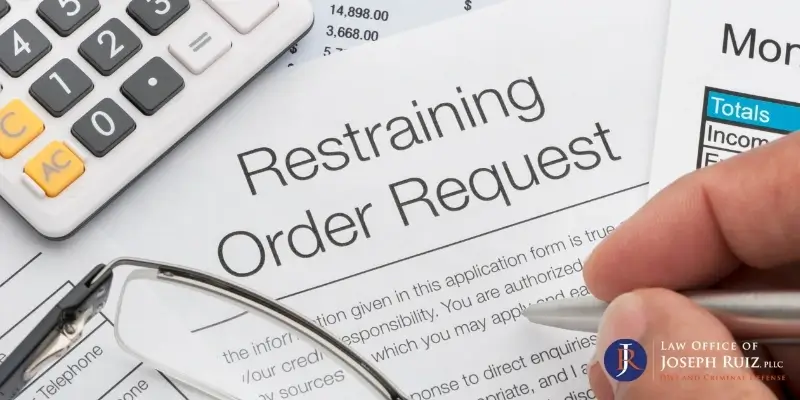|
|
Last Modified on Jan 05, 2026
When you’re facing threats, harassment, or violence, and you need immediate protection, understanding how to file a restraining order in Texas is imperative.
A restraining order restricts contact and actions from the person putting you or your loved ones in danger. Whether it’s a spouse, ex-partner, family member, or another person, Texas law provides a way for you to get the protection you need.
32 people experience intimate partner violence every minute. 41% of women and 26% of men experience situations that require a restraining order, resulting in 72% of those with protective orders claiming it helped.
Filing a restraining order in Texas involves several steps:
Step 1: Determine the Type of Restraining Order You Need
Before filing, it’s important to understand that Texas offers several kinds of protective orders. Each is designed for different scenarios, and they include:
- Temporary ex parte protective order. This is an emergency order that can be granted without notifying the other party. It typically lasts up to 20 days and can be extended.
- Final protective order. After a hearing, wherein both sides can present evidence, the court could issue a longer-term order lasting up to two years, but this timeframe can be even longer under certain circumstances.
- Magistrate’s order for emergency protection (MOEP). This type of order is often issued by a criminal court judge after an arrest involving family violence, stalking, or sexual assault.
Choosing the right type of protective order enables you to get the protection you need, tailored to your specific circumstances. Each order offers varying degrees of safety and legal authority, so starting with the right one is crucial.
Step 2: Gather the Information and Evidence You Need
To request a protective order, you must provide convincing details to the court. Your petition should clearly explain what happened and why you fear future harm. Some key information to incorporate includes:
- The nature of your relationship with the respondent
- Specific incidents of violence, threats, stalking, or harassment
- Dates, times, and any witnesses
- Photos of injuries or property damage
- Police reports or medical records (if available)
The stronger and more organized your evidence, the more likely the judge is to grant immediate relief. While everything doesn’t have to be perfect, presenting clear, credible evidence helps the court understand the seriousness of your situation, which could lead to quicker, stronger protection.
Step 3: File the Protective Order Petition With the Court
You must file your petition with the district or county court in the county where you or the respondent lives. Filing the petition is an empowering step, and hiring an experienced attorney can make the process less intimidating.
Step 4: Serve the Respondent
Once the order is filed, the respondent must be formally served with the documents. This is handled by law enforcement or a process server. The respondent receives:
- A copy of your petition
- Any temporary orders
- The hearing date for the final order
Proper service is important because it triggers the respondent’s legal obligation to attend the hearing and comply with the temporary order. Making sure the respondent is served moves the legal process forward and upholds your safety under the law.
Step 5: Attend the Court Hearing
At the hearing, both parties present evidence, call witnesses, and testify. A judge then decides whether to issue a final protective order, based on the facts.
The court evaluates whether violence has occurred and is likely to happen again. If the judge rules in your favor, the final order could include provisions like:
- No contact or communication
- Stay-away zones around your home, job, or school
- Firearm restrictions
- Custody or visitation modifications (if children are involved)
The hearing is your opportunity to be heard. Preparation and courage can persuade the court to make a decision that protects your safety and rights.
What Happens After the Order Is Granted?
If granted, the final protective order is then enforceable by law enforcement, and violating the order can lead to arrest, fines, and jail time for the respondent. Keep multiple copies of your order and distribute them to:
- Your local police department
- Your workplace or school
- Your child’s daycare or school
- Any place where you spend regular time
A final order is a legal shield backed by the full force of Texas law. Make sure to keep your copies accessible and take steps to maintain your safety.
FAQs
Can a Restraining Order Be Issued If No Physical Violence Occurred?
Yes. In Texas, protective orders can be issued based on threats, stalking, harassment, or emotional abuse, even if no physical harm occurred. The key is whether the behavior puts you in fear of serious harm or constitutes a pattern of intimidation. Courts consider the overall context and frequency of the conduct when deciding whether to grant an order.
What Happens If the Respondent Moves to Another State?
If the respondent relocates to another state, your Texas protective order remains in effect. Protective orders issued in one state are recognized and enforced by law enforcement in other states. To ensure continued protection, you should provide a copy of your order to the police department in your area and, if possible, to authorities in the respondent’s new location.
Can I Get a Protective Order for My Child, Even If I Don’t Want One for Myself?
Yes. Texas law allows parents or guardians to request protective orders on behalf of minors. If your child is being threatened, abused, or stalked—even by a family member—you can file a petition to protect them. The court might include terms that ensure school safety, supervised visitation, or no-contact provisions.
Can a Protective Order Affect the Respondent’s Job or Professional License?
Yes, a protective order can affect the respondent’s job or professional license. Certain employers, especially in law enforcement, healthcare, or positions requiring a firearm, could take action against someone who is under a protective order. Additionally, restraining orders can show up in background checks, which could affect professional licensing or employment opportunities.
Contact the Law Office of Joseph Ruiz, PLLC
At the Law Office of Joseph Ruiz, PLLC, we understand that seeking a restraining order is a deeply personal and often distressing experience. We’ve helped countless individuals navigate this process with compassion, clarity, and professionalism, and we can be your advocate as well.
Contact our firm today to schedule a consultation.







